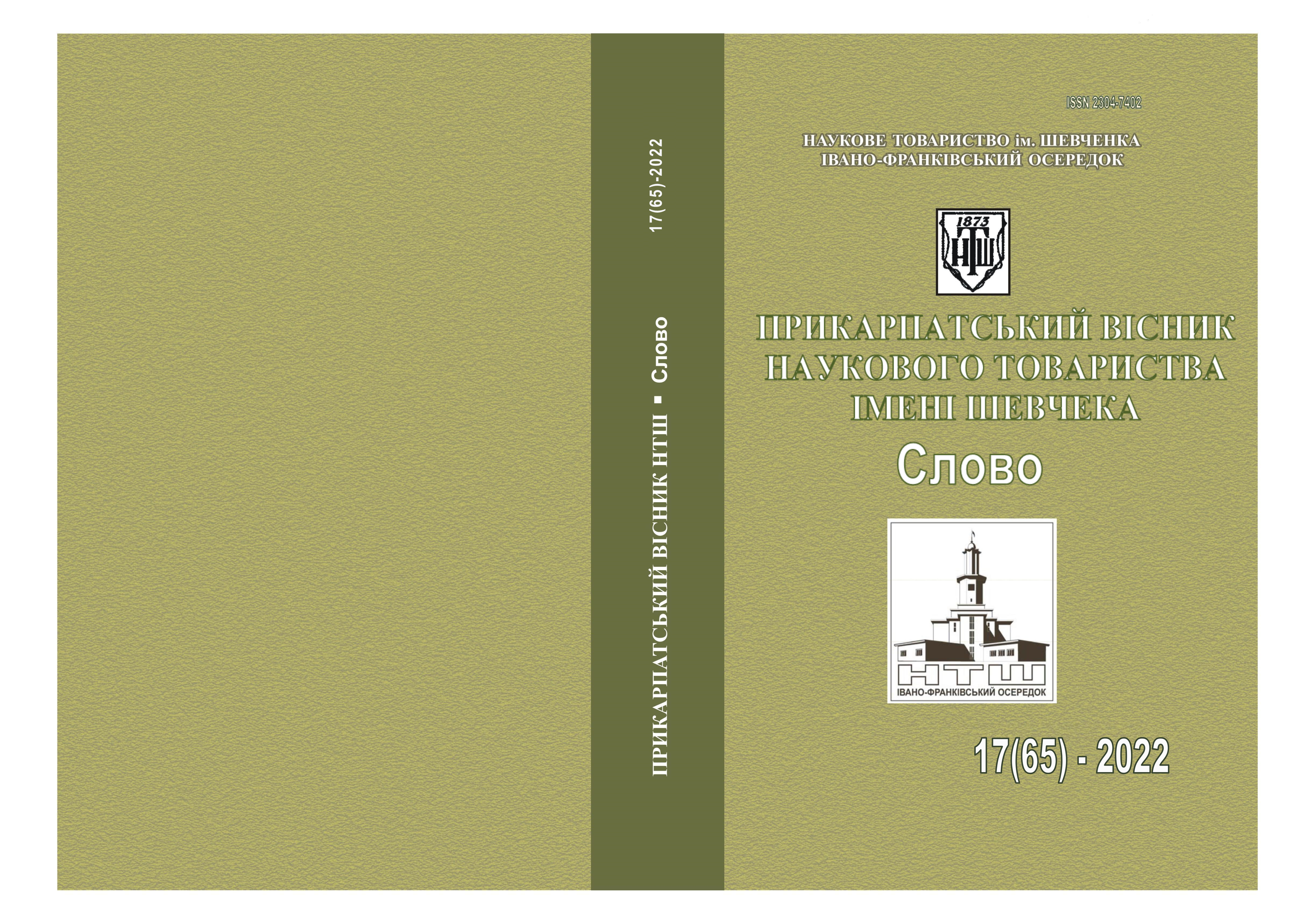COGNITIVE SPHERES OF ICONOTROPISM
DOI:
https://doi.org/10.31471/2304-7402-2022-17(65)-362-371Keywords:
iconotropism, iconicity, representation, visualization, cognitivismAbstract
In contemporary literary research, wecan see a tendency for avoiding the term 'iconotropism' or vague interpretation and awareness of its role in fiction. Therefore, in this article, we considerit expedient to follow in detail the definition of the term, its etymology, and evolution, as well as, in the long run, its integration in to the literary field and signs in postmodern literature, which is the purpose of this study. It is important to note that in the article we will rely on the semantic-cognitive analysis of iconotropism, as the meaning of this term, in our opinion, is fully displayed namely in the awareness of the mental and biological processes of the human body, and its evolution. Recently, there has been an increasing interest in the examination of literary studies' questions with cognitivism. "Cognitive literary studies", whicharoseat the end of the 20th century, still remain on the margin of literature research. However, nonetheless, in our opinion, it is worth paying attention precisely in the context of the study of iconotropism. The methodological basis of the article is the works of literature researchers Ellen Spolsky, Roston Murray, and neuroanthropologist Terrence Deacon, who avouchthe expedience of studying literature precisely through the prism of the cognitive processes of the individual. The nature of iconotropism is directly connected with the evolution of man and his natural craving for icons.
As a result, several interpretations of "iconotropism" have been identified; its development has been traced in a diachronic aspect; the cognitive spheres of iconotropism have been out lined; it has been proven that this very term quite well denotes what is an actual basis of a literary work – the visual interpretation of its content, the peculiarity of the reader's perception of a literary piece, and, finally, people's passion for art (in this consists practical value and novelty of this study). Analyzing the poetics of postmodernism in the context of iconotropy, the peculiarity of such iconic concepts as "labyrinth", "rhizome", "fractal" has been characterized.
References
Бистров Я.В. Фрактальна рекурсія у біографічному оповідному тексті: лінгво синергетичний аспект. Наукові записки. Серія «Філологічна». Острог: Вид-во Національного університету «Острозька академія», 2015. Вип. 59. С. 26-28. URL: http://nbuv.gov.ua/UJRN/Nznuoaf_2015_59_10
Бовсунівська Т.В. Когнітивна жанрологія та поетика: монографія. К.: Видавничо-поліграфічний центр «Київський університет», 2010. 180 с.
Бровко О. О. Rhizomeversustrees: естетичні можливості колажної поетики. Масова література: проблеми інтерпретації, змісту та форми: Матеріали міжнародної науково-практичної конференції 16-17 жовтня 2015 року. с. 22-25. URL:https://elibrary.kubg.edu.ua/
Делез Ж., Гваттари Ф. Ризома. Эстетика и теория искусства XX века: Хрестоматия/ Сост. Н.А. Хренов. А.С. Мигунов. Москва: Прогресс-Традиция, 2008. С. 296–306.
Дианова В.М. Постмодернистская философия искусства: истоки и современность. СПб., 2000. URL:http://anthropology.ru/ru/texts/dianova/ppa
ЛавриновичЛ. Б. Художня інтерпретація ідеї часопростору в романі О. Токарчук «Prawiek i inneczasy». Наукові записки. Серія «Філологіч-на». Острог : Вид-во Національного університету «Острозька академія», 2012. Вип. 28. С. 128-139.
Літературознавчий словник-довідник / за ред.: Р. Т. Гром'яка, Ю. І. Коваліва, В. І. Теремка. 2-ге вид., випр., допов. Київ : Академія, 2007. 752 с.
Набитович І. Й. Концепт лабіринту як сакрального локусу (на прикладі новелістики Х.Л. Борхеса, романів У. Еко «Ім’я рози» та К. Мосс «Лабіринт»). МАҐІСТЕРІУМ. Літературознавчі студії. 2010. Випуск 38. с. 42-51.
Солецький О.М. Емблематичні структури психоаналізу (теорія М.Кляйн і іконічно-конвенційна сигніфікація). Держава та регіони. Серія: Гуманітарні науки. 2017. №2 (49). С.4-10.
Солецький О.М. Емблематичні форми дискурсу: відміфу до постмодерну: монографія. Івано-Франківськ: «Лілея-НВ», 2018. 400 с.
Солецький О.М. Тілесний іконотропізм Василя Стефаника. Прикарпатський вісник Наукового товариства імені Шевченка. Слово. 2022. N 16(63). С. 187-196.
Фестингер Л. Введение в теорию диссонанса. Современная зарубежная социальная психология. М.: Издательство Московского университета, 1984. С.105.
García, Jorge Tomás, and Sandra Sáenz-López Pérez, eds. Iconotropy and cult images from the ancient to modern world. Routledge, 2022. URL: https://www.taylorfrancis.com
Roston Murray. Changing perspectives in literature and the visual arts, 1650-1820. Vol. 1066. Princeton University Press, 2014. URL: ttps://www.degruyter.com/document/doi/10.1515/9781400860913/html
Spolsky E. Iconotropism as Representational Hunger: Raphael and Titian. Iconotropism: Turning Toward Pictures, 2010. Р. 23-36. URL: http://dx.doi.org/10.17613/n9aj-jq60
Spolsky E. Archetypes Embodied, Then and Now. Poetics Today, 2017. 38(2), p.317-339.
Spolsky E. Introduction: Iconotropism or Turning toward pictures. Iconotropism: turning toward pictures /edited by Ellen Spolsky. Lewisburg, PA. Bucknell University Press, (c) 2004. Р.11–19.
Deacon Terrence William. The symbolic species: The coevolution of language and the brain. New York: WW Norton & Company, 1998. N. 202. p.221.
William J. Hamblin. “Iconotropy and the JS Abraham Facsimiles”, The Interpreter Foundation, 7 de abril de 2013. URL: https: //interpreterfoundation.org/blog-iconotropy-and-the-js-abraham-facsimiles/

